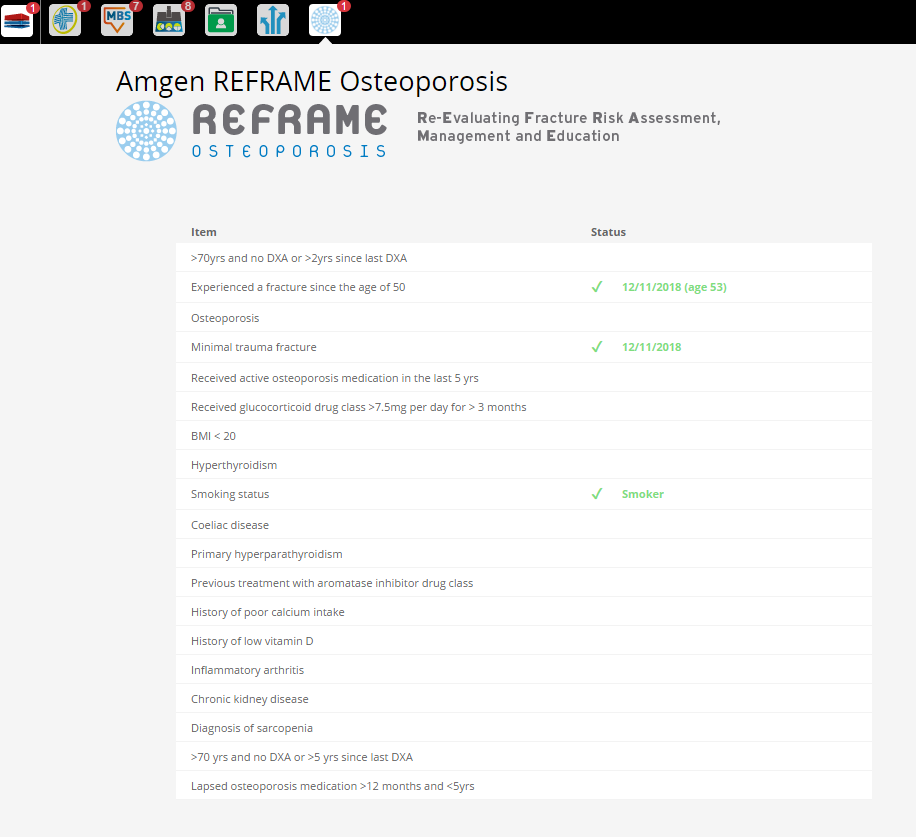The Amgen REFRAME app provides easy access to reporting relating to patients that have osteoporosis risk factors and gives the users a simple view of the patient's risk and other relevant factors in one table.
The app will apply the following patients:
- Patients over 70 years of age and never had a DXA, or have not had a DXA within the last 2 years
Or
- Patients that have experienced a fracture since the age of 50
When a patient meeting one of the criteria above is opened in your clinical system, the app will become active and show a notification in a red circle:
n
Clicking on the app icon will open it in full screen and display all relevant information in a table view:
If there is no information in the patient record, only the name of the indicator will be displayed. If the information is available, it will be displayed in green.
The following columns will be displayed within the app and populated if the data is stored within the patients record in a coded format.
| Item | Column Name | Data Mapping |
|---|---|---|
1 | >70yrs and no DXA or >2yrs since last DXA | Y or blank (nothing displayed) |
2 | Experienced a fracture since age of 50 | Y or blank (nothing displayed) |
3 | Osteoporosis | Y or blank (nothing displayed) |
4 | Minimum Trauma Fracture | Y or blank (nothing displayed) |
5 | Received bone active medication in the last 5yrs | Y or blank (nothing displayed) |
6 | Glucocorticoid drug class >7.5mg per day for >3 months | Y or blank (nothing displayed) |
7 | BMI <20 | Y or blank (nothing displayed) |
8 | hyperthyroidism | Y or blank (nothing displayed) |
9 | Smoking | Smoking status from the clinical system or blank |
10 | Coeliac Disease | Y or blank (nothing displayed) |
11 | Primary Hyperparathyroidism | Y or blank (nothing displayed) |
12 | Previous treatment with aromatase inhibitor drug class | Y or blank (nothing displayed) |
13 | History of poor calcium intake | Y or blank (nothing displayed) |
14 | History of low vitamin D | Y or blank (nothing displayed) |
15 | Inflammatory conditions associated with bone loss | Y or blank (nothing displayed) |
16 | CKD | Please see below for details on this indicator |
17 | Diagnosis Sarcopenia | Y or blank (nothing displayed) |
| 18 | >70yrs and no DXA or >5yrs since last DXA | Y or blank (nothing displayed) |
| 19 | Lapsed Osteoporosis medication >12mths and <5yrs | Y or blank (nothing displayed) |
CKD displays stages of CKD (indicated or diagnosed) as well as likelihood of the indication based on the extracted pathology
Patients on dialysis are displayed as 'level 5' CKD. For this report CAT will ignore any diagnosis of Kidney disease and the displayed indicated stages are purely based on the Colour codes and their meaning: Red Orange Yellow For more information refer to Kidney Health Australia web site and the CKD Guideline Booklet available at www.kidney.org.au For full details on the CKD stage calculation please see here: http://kidney.org.au/cms_uploads/docs/02_algorithm-for-inital-detection-of-ckd.pdf |

